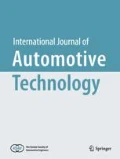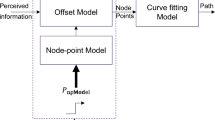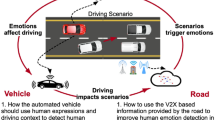Abstract
As partially automated driving vehicles are set to be mass produced, there is an increased necessity to research situations where such partially automated vehicles become unable to drive. Automated vehicles at SAE Level 3 cannot avoid a take-over between the human driver and vehicle system. Therefore, how the system alerts a human driver is essential in situations where the vehicle autonomous driving system is taken over. The present study delivered a take-over transition alert to human drivers using diverse combinations of visual, auditory, and haptic modalities and analyzed the drivers’ brainwave data. To investigate the differences in indexes according to the take-over transition alert type, the independent variable of this study, the nonparametric test of Kruskal-Wallis was performed along with Mann-Whitney as a follow-up test. Moreover, the pre/post-warning difference in each index was investigated, and the results were reflected in ranking effective warning combinations and their resulting scores. The visual-auditory-haptic warning scored the highest in terms of various EEG indexes, to be the most effective type of take-over transition alert. Unlike most preceding studies analyzing post-take-over-alert human drivers’ response times or vehicle behavior, this study investigates drivers’ brainwave after the take-over warning.
Similar content being viewed by others
References
Baek, S., Yun, H. and Yang, J. H. (2019). How do humans respond when automated vehicles request an immediate vehicle control take-over?. Automotive UI’19 (Accepted).
Borojeni, S. S., Chuang, L., Heuten, W. and Boll, S. (2016). Assisting drivers with ambient take-over requests in highly automated driving. Proc. 8th Int. Conf. Automotive User Interfaces and Interactive Vehicular Applications., Ann Arbor, Michigan, USA.
Chae, S., Kyung, G., Park, S., Nam, K., Lee, K. and Lee, Y. H. (2012). A study on the relationship between emotions and brain signals evoked by head-up display images. Proc. Autumn Conf. Ergonomics Society of Korea, Pyeongchang, Korea.
Cho, K. and Moon, J. (2014). Direction for support of MOTIE R&D in autonomous driving vehicle. J. Korean Society of Automotive Engineers36, 7, 20–25.
Chuang, L. L., Glatz, C. and Krupenia, S. (2017). Using EEG to understand why behavior to auditory in-vehicle notifications differs across test environments. Proc. 9th ACM Int. Conf. Automotive User Interfaces and Interactive Vehicular Applications, Oldenburg, Germany.
Gold, C., Dambock, D., Lorenz, L. and Bengler, K. (2013). “Take over!” How long does it take to get the driver back into the loop?. Proc. Human Factors and Ergonomics Society Annual Meeting57, 1, 1938–1942.
Hester, M., Lee, K. and Dyre, B. P. (2017). Driver take over: A preliminary exploration of driver trust and performance in autonomous vehicles. Proc. Human Factors and Ergonomics Society Annual Meeting61, 1, 1969–1973.
Jeon, M. (2017). Emotions in driving. Emotions and Affect in Human Factors and Human-Computer Interaction. Academic Press. USA, 437–474.
Kim, D. Y., Lee, J. H., Park, M. H., Choi, Y. H. and Park, Y. O. (2017). Trend in brain wave signal and application technology. Electronics and Telecommunications Trends32, 2, 19–28.
Kim, H. S., Hwang, Y., Yoon, D., Choi, W. and Park, C. H. (2014). Driver workload characteristics analysis using EEG data from an urban road. IEEE Trans. Intelligent Transportation Systems15, 4, 1844–1849.
Kim, S., Rhee, W., Choi, D., Jang, Y. J. and Yoon, Y. (2018). Characterizing driver stress using physiological and operational data from real-world electric vehicle driving experiment. Int. J. Automotive Technology19, 5, 895–906.
Lee, J., Yun, H., Kim, J., Baek, S., Han, H., FakhrHosseini, S. M., Vasey, E., Lee, O., Jeon, M. and Yang, J. H. (2019). Design for single-modal take-over request in SAE level 2 & 3 automated vehicle. Trans. Korean Society of Automotive Engineers27, 3, 171–183.
Louw, T. and Merat, N. (2017). Are you in the loop? Using gaze dispersion to understand driver visual attention during vehicle automation. Transportation Research Part C:Emerging Technologies, 76, 35–50.
Naujoks, F., Mai, C. and Neukum, A. (2014). The effect of urgency of take-over requests during highly automated driving under distraction conditions. Advances in Human Aspects of Transportation 7 (Part I), Wurzburg, Germany, 431–438.
Park, C., Shahrdar, S. and Nojoumian, M. (2018). EEG-based classification of emotional state using an autonomous vehicle simulator. Proc. IEEE 10th Sensor Array and Multichannel Signal Processing Workshop (SAM), Sheffield, UK.
Park, S. S., Hu, H. and Lee, W. S. (2010). A study on physiological signal changes due to distraction in simulated driving. J. Ergonomics Society of Korea29, 1, 55–59.
Yoon, S. H., Kim, Y. W. and Ji, Y. G. (2019). The effects of takeover request modalities on highly automated car control transitions. Accident Analysis & Prevention, 123, 150–158.
Yun, H., Kim, S. L., Lee, J. W. and Yang, J. H. (2018). Analysis of cause of disengagement based on U.S. California DMV autonomous driving disengagement report. Trans. Korean Society of Automotive Engineers26, 4, 464–475.
Yun, H. and Yang, J. H. (2019). Multi-modal warning design for take-over request in partially automated vehicle. European Transport Research Review (Under Review).
Yun, Y. (2016). Trend and issue of driver-vehicle interface for autonomous vehicle. J. Korean Society of Automotive Engineers38, 2, 34–40.
Acknowledgement
This work was supported by a grant (code 18TLRP-B131486-02) from Transportation and Logistics R&D Program funded by Ministry of Land, Infrastructure and Transport of Korean government. The corresponding author was partly supported by the Basic Science Research Program of the National Research Foundation of Korea, which was funded by the Ministry of Science, ICT, and Future Planning (2017R1A2B400 8615). The authors thank Hanna Yun, Jaewon Kim, and Sujin Baek for collecting and analyzing data.
Author information
Authors and Affiliations
Corresponding author
Additional information
Publisher’s Note
Springer Nature remains neutral with regard to jurisdictional claims in published maps and institutional affiliations.
Rights and permissions
About this article
Cite this article
Lee, J., Yang, J.H. Analysis of Driver’s EEG Given Take-Over Alarm in SAE Level 3 Automated Driving in a Simulated Environment. Int.J Automot. Technol. 21, 719–728 (2020). https://doi.org/10.1007/s12239-020-0070-3
Received:
Revised:
Accepted:
Published:
Issue Date:
DOI: https://doi.org/10.1007/s12239-020-0070-3




